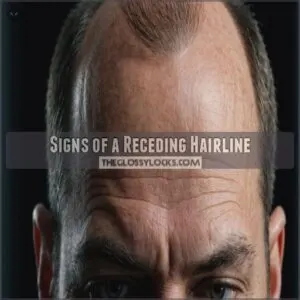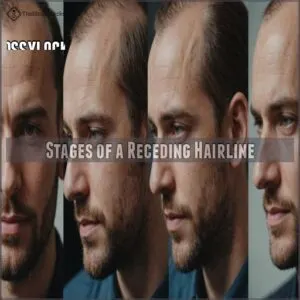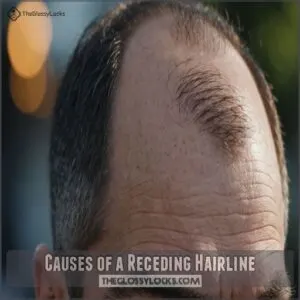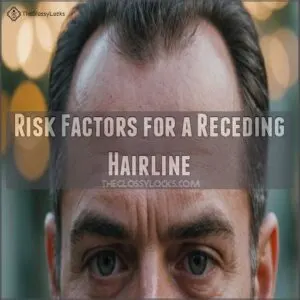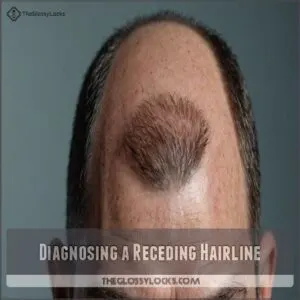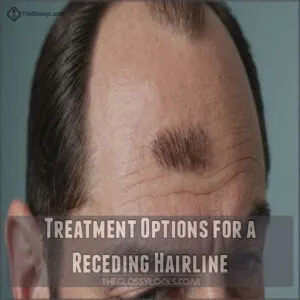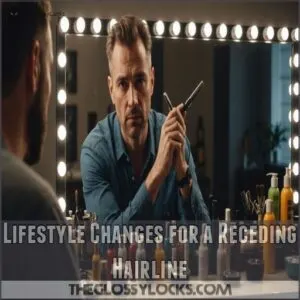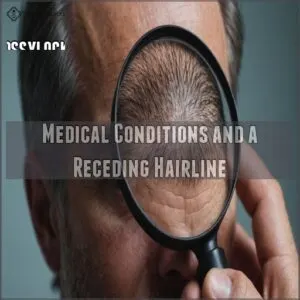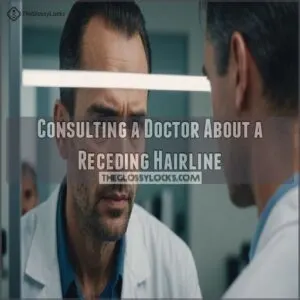This site is supported by our readers. We may earn a commission, at no cost to you, if you purchase through links.
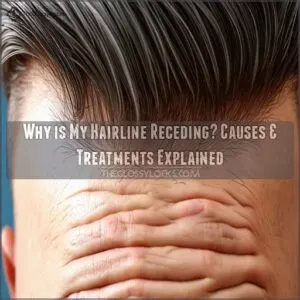 Wondering why your hairline is receding? It’s like a game of genetics, lifestyle choices, and a bit of stress thrown in for good measure. Male pattern hair loss tops the list, often thanks to family history. But don’t stress (literally)—stress itself can play a role too, alongside poor diet and excessive styling.
Wondering why your hairline is receding? It’s like a game of genetics, lifestyle choices, and a bit of stress thrown in for good measure. Male pattern hair loss tops the list, often thanks to family history. But don’t stress (literally)—stress itself can play a role too, alongside poor diet and excessive styling.
Even sneaky conditions like frontal fibrosing alopecia and hormonal changes could be culprits. Notice excessive shedding, thinning, or a suspicious M or V shape starting to appear? You’re not alone. Unpacking these mysteries might even offer solutions to keep those strands in place.
Curious about treatments?
Table Of Contents
- Key Takeaways
- Signs of a Receding Hairline
- Stages of a Receding Hairline
- Causes of a Receding Hairline
- Risk Factors for a Receding Hairline
- Diagnosing a Receding Hairline
- Treatment Options for a Receding Hairline
- Lifestyle Changes for a Receding Hairline
- Medical Conditions and a Receding Hairline
- Psychological Impact of a Receding Hairline
- Consulting a Doctor About a Receding Hairline
- Frequently Asked Questions (FAQs)
- Can a receding hairline grow back?
- How do I fix my receding hairline?
- Why am I 14 with a receding hairline?
- Is a receding hairline at 18 normal?
- Can hats cause my hairline to recede?
- How does stress affect hairline recession?
- Will changing my shampoo help my hairline?
- What vitamins support healthy hairline?
- Does frequent hair washing impact my hairline?
- Conclusion
Key Takeaways
- You’ll likely experience a receding hairline due to genetics, so understanding your family history is crucial.
- Lifestyle factors like stress, poor diet, and harsh styling significantly impact hair health and can accelerate hair loss.
- Several effective treatments exist, including medications, therapies, and hair transplants, offering various options depending on your needs and preferences.
- Early diagnosis and proactive management are key to slowing or preventing further hair loss and maintaining a healthy hairline.
Signs of a Receding Hairline
You might notice your hairline receding if hair is thinning around your temples or shedding excessively.
Keep an eye out for changes in hair texture and volume, as these can also be early signs.
Hair Loss Around The Temples
Before you jump to conclusions, hair loss around the temples might be one of the first signs of a receding hairline.
It’s that pesky temple hair loss that can signal the early stages of male pattern baldness or androgenetic alopecia.
Don’t stress too much; if you’re experiencing balding, consider trying Hairstyles for Balding Men, which can help boost confidence and create a masculine appearance. There are temple hair loss treatments and styling tips to help manage hair thinning effectively and stylishly.
Texture and Volume Changes
Spotting texture and volume changes? These can signal a receding hairline. Noticing a difference might mean it’s time for action.
Consider these strategies:
- Hair texture changes with thinning
- Volume loss causes different styling needs
- Opt for styling tips to add volume
- Update your hair care routine regularly, and also look into taking Hair growth vitamins for extra support
- Explore product recommendations to boost appearance
Stay proactive for better hair health.
Excessive Shedding
Noticeably more hair in your brush or shower drain? That’s a significant sign.
Excessive shedding, often linked to stress or poor diet, is a common early warning of a receding hairline.
This increased hair loss, sometimes called telogen effluvium, can be a symptom of underlying issues.
Addressing scalp health and improving your hair care routine are key first steps.
Consider hair loss supplements or medication if the problem persists.
Don’t panic; there are solutions!
Stages of a Receding Hairline
As your hairline begins its retreat, it follows a series of recognizable stages, each marked by specific patterns of hair thinning and loss.
From the initial subtle recession at the temples to more noticeable changes like the formation of an "M" or "V" shape, understanding these stages can help you identify where you stand in the process.
Stage 1 – Gradual Recession
You’re noticing your hairline making a quiet retreat, marking Stage 1 – Gradual Recession. It’s not immediately obvious, but keep an eye on early signs:
- Hair thinning around temples
- Subtle changes in texture
- Increased shedding
- Scalp more visible under light
- Adjusting hair care routine
Stay proactive with prevention tips and understanding hair loss myths to maintain control and confidence.
Stage 2 – M or V Shape Hairline
Stage 2 marks the evolution of your hairline into an "M" or "V" shape, emphasizing a noticeable change often linked with traction alopecia or genetics.
Here’s a quick guide if you’re exploring options:
| Hairline Shape | Causes of V | Treatment Options |
|---|---|---|
| "M" Shape | Genetics | Minoxidil |
| "V" Shape | Traction alopecia | Finasteride |
| Both | Female-pattern baldness | Hair loss surgery |
| Stress and lifestyle | Hair loss support | |
| Styling Tips |
This stage’s progression varies; understanding its causes helps maintain control.
Stage 3 – Hair Loss at The Forehead
As your hairline recedes further, Stage 3 reveals more forehead exposure.
This hair loss at the center becomes more noticeable, often demanding new strategies.
Consider embracing your new look with styling options that flatter a changing hairline.
Hair loss treatments like minoxidil and finasteride, such as those that block DHT production, can help.
If needed, surgical hair restoration might be the right path to explore.
Stage 4 – Bald Spot at The Crown
Hair loss migrating from your forehead might become a bald spot at the crown. To combat this, many men opt for classic slicked-back styles that disguise thinning spots and create a polished look. —Stage 4 of hairline recession.
This can feel like a new surprise party on top of your head.
Consider crown bald spot treatments like PRP therapy or hair transplant options.
Managing stress, maintaining a healthy lifestyle, and avoiding harsh styling can also aid in prevention.
Stage 5 – Thinning Strip of Hair
You might notice a thinning strip of hair linking your temples and a growing bald spot on your crown.
This stage can be tricky, like walking a hairline tightrope!
Fortunately, you’re not alone.
Consider hair loss solutions like minoxidil, hair transplant options, or even a new style to embrace this unique stage.
Supplements and a healthier lifestyle can also support hair growth.
Stage 6 – Connecting Hair Loss
That thin strip’s getting thinner, huh? Welcome to Stage 6, where the crown’s thinning connects with your receding temples.
It’s a significant step, but don’t panic! Explore treatment options like a hair transplant or consider styling tips to camouflage the change.
Remember, many effective treatments exist, and a consultation with a doctor can help you find the right path forward. Don’t let this phase define you.
Stage 7 – Visible Hair Loss at The Top
From Stage 6, where the crown and temple hair meet in rare harmony, we move to Stage 7.
Here, hair loss at the top is obvious, leaving a mere band of hair affectionately known as a "hoop."
At this point, considering hair transplant options and styling tips can be handy for maintaining a sense of control and confidence.
Causes of a Receding Hairline
When your hairline starts pulling back like a retreating army, it’s not just a random event.
It often results from factors like genetics, aging, stress, or even overenthusiastic hair styling.
Male Pattern Hair Loss
It’s possible your hairline’s retreat is due to male pattern hair loss, a genetic condition affecting millions.
The culprit? A hormone called DHT.
Don’t be fooled by hair loss myths; DHT blockers could help.
Focus on scalp health, and remember, options like hair transplants or non-surgical treatments can bring your hair back in the game.
Frontal Fibrosing Alopecia
Worried about that creeping hairline?
Frontal fibrosing alopecia might be behind it.
This condition, often affecting women post-menopause, targets your hairline, causing scarring and permanent hair loss.
You’ll notice redness, and perhaps eyebrows thinning too.
Diagnosis involves a skin biopsy.
While treatment varies, corticosteroids and anti-inflammatory medications can slow progress.
Preventive measures remain limited, so early action is key!
Physical and Mental Stress
How does stress impact your hairline?
Physical and mental stress can send your hair into a tizzy, triggering hormone spikes that mess with hair growth.
Stress management is key—try deep breathing or yoga to keep those stress hormones in check.
It’s your cue to prioritize mental health, so your hair has a fighting chance to stay firmly rooted.
Poor Diet and Sedentary Lifestyle
Stress can affect your hair, but don’t overlook the impact of what you eat and how often you move.
A poor diet lacking nutrition and a sedentary lifestyle can stall hair growth.
Choose better food options and incorporate exercise into your routine.
These lifestyle changes benefit your overall health and can also support a fuller hairline.
Excessive Styling
Because excessive styling can damage hair follicles, leading to hair loss, it’s important to be mindful of your routine.
Overuse of hair styling products, heat styling tools, and tight hairstyles can all contribute to a receding hairline.
Think of your hair like a delicate plant; it needs care and gentle treatment!
- Limit heat styling.
- Avoid tight hairstyles like ponytails or braids.
- Choose gentler hair styling products.
Family History and Genetics
While hair products can sometimes stress your tresses, it’s often your Family Ties that determine hairline fate.
Genetic Hair Loss is a common tale, passed down like grandma’s secret recipes. Your Genetic Predisposition might mean a receding hairline, thanks to Inherited Traits or even Ethnic Factors.
So, next family gathering, thank them for the hair—thinning or not!
Hormone Changes and Aging
You might wonder how family history plays a role in hair loss, but hormone changes and aging bring significant challenges too. Your hairline can retreat as androgen imbalances occur and follicles age.
Women face menopause hair loss, and men may consider hormone replacement therapy. Stay informed to manage perimenopause symptoms effectively.
- Consult professionals for personalized advice
- Explore treatment options
- Maintain a balanced lifestyle
Risk Factors for a Receding Hairline
Understanding why your hairline is receding can help you address the issue effectively.
Several risk factors might be at play, including age and genetics.
Medical conditions, medications, and lifestyle choices all influence your hairline’s health.
Age and Genetics
A receding hairline often has age and genetics as the main culprits.
Your family history might be silently chiming in, especially if hair loss runs deep in your genes.
Age-related hormones play their part too, slowly guiding your hairline back.
Curious about your odds? Genetic testing can uncover inherited traits, giving you insight into your locks’ future with a nod to ethnicity factors.
Medical Conditions and Medications
Receding hairlines can sneak up due to various medical factors.
Consider these:
- Infectious Causes: Scalp infections might lead to hair loss.
- Autoimmune Disorders: Your immune system could mistakenly attack hair follicles.
- Medication Side Effects: Some prescriptions list hair thinning as a downside. If you’re experiencing this, you may want to explore effective hair thinning treatments.
- Thyroid Issues: An overactive or underactive thyroid disrupts hair growth.
Keeping an eye on these can help you tackle that hairline.
Lifestyle Choices and Stress
Managing a receding hairline can feel like trying to catch sand in the wind, especially with lifestyle choices and stress at play.
Stress and sleep deprivation often aggravate hair loss.
Occupational hazards and social pressures add to the mix, making relaxation methods essential.
Embrace stress management techniques, like mindful breathing and yoga, to potentially curb those hairline woes.
Diagnosing a Receding Hairline
To diagnose a receding hairline, a doctor will start with a visual examination and ask about your medical history, which provides clues to your hair loss.
They’ll also use techniques like the pull test or a scalp biopsy, and may recommend blood tests to rule out underlying conditions.
Visual Examination and Medical History
No two hairlines recede quite the same, and understanding yours begins with a visual examination.
Doctors assess scalp conditions and check family hair loss patterns, often considering the Norwood scale for male pattern baldness.
They’ll explore your personal hair loss timeline, possibly noting scalp infection symptoms, and considering the role of hormones, such as DHT and hair loss.
These insights guide hair follicle analysis.
With this clear picture, you’re better armed to navigate treatment options confidently, ensuring safer steps forward.
Pull Test and Scalp Biopsy
After the visual check, your doctor might suggest a pull test and scalp biopsy for a detailed hair loss diagnosis.
The pull test checks how easily your hair comes out, while a biopsy helps analyze hair follicle health.
The biopsy procedure isn’t as intimidating as it sounds—it just involves a small skin sample to pinpoint treatment options for better scalp health.
Blood Tests and Ruling Out Conditions
Sometimes, a receding hairline might be more than just bad luck.
Roll up your sleeves because blood tests are your first stop to rule out thyroid issues, anemia, or hormonal imbalances.
These tests help identify underlying medical conditions that could be at play.
Catching these issues early can make a world of difference in choosing the right treatment.
Treatment Options for a Receding Hairline
If you’re looking to deal with a receding hairline, you’ve got several promising treatment options at your disposal.
From medications like Minoxidil and Finasteride to advanced procedures like PRP therapy, low-level laser therapy, and hair transplants, understanding these choices can help you decide on the best approach for your needs.
Minoxidil and Finasteride
Facing a receding hairline? Understanding your options is key.
Minoxidil, a topical solution, stimulates hair growth, but it might cause irritation.
Finasteride, an oral medication, blocks DHT, a hormone linked to hair loss. However, it can have side effects.
Effectiveness varies, depending on the individual and the stage of hair loss.
Dosage and cost differ depending on the brand and prescription.
Always discuss the benefits of incorporating a green tea cleansing mask into your skincare routine, as it can also contribute to overall skin health, and potential side effects and the best application tips with your doctor before starting either treatment.
PRP Therapy and Low-Level Laser Therapy
Minoxidil and Finasteride aren’t your only answers.
Enter PRP therapy, injecting platelets to spur hair growth.
It’s effective, but the cost can be steep, and typically requires three initial sessions.
Then, there’s low-level laser therapy (LLLT), a less invasive option to stimulate follicles.
Comparing LLLT vs. PRP, consider PRP’s benefits and LLLT’s side effects.
Both offer new hope for your hairline woes.
Hair Transplant and Restoration Surgery
Hair transplant and restoration surgery could be your ticket from thinning woes to a fuller look.
With costs varying, think ahead about the financial side.
Recovery isn’t overnight; give yourself time and care.
Watch out for risks like infection or unnatural growth.
Success rates are high, but exploring alternatives offers control over your choices, ensuring the right path for you.
Lifestyle Changes for a Receding Hairline
You can support your receding hairline by making sensible lifestyle changes like improving your diet and managing stress effectively.
Regular exercise and attentive hair care are simple yet powerful steps to bolster your hair’s health and strength.
Healthy Diet and Stress Management
While considering treatments, don’t forget the power of lifestyle shifts.
Nourishing your scalp with a balanced diet helps combat hair woes.
Reducing stress can prevent those frustrating hair problems.
Here’s how you can enhance your hair health:
- Eat foods rich in vitamins and minerals
- Reduce stress with meditation or hobbies
- Stay hydrated for scalp moisture
- Sleep well to support hair growth
These tips offer a helpful boost!
Regular Exercise and Hair Care
Feeling overwhelmed by stress? Regular exercise can boost scalp health and also aids in hair growth and stress relief. You’re juggling a lot, yet a little movement goes a long way.
Also, consider gentle hair care—think soothing shampoos and less heat styling to prevent hair loss.
| Exercise Benefit | Hair Growth Tip | Scalp Health Tip |
|---|---|---|
| Stress relief | Avoid tight hairstyles | Use mild shampoos |
| Improved blood flow | Eat protein-rich foods | Massage with oils |
| Hormone balance | Reduce heat styling | Hydrate regularly |
Medical Conditions and a Receding Hairline
You might notice your hairline receding due to underlying medical conditions like thyroid disease, hormone imbalances, autoimmune disorders, or skin infections.
These health issues can disrupt normal hair growth, making it important to understand their impact on your hair’s appearance.
Thyroid Disease and Hormone Imbalance
Beyond lifestyle, underlying health plays a role.
Thyroid problems, for instance, can disrupt your hormones, impacting hair growth.
Hormonal imbalances, common in women, especially during menopause, often lead to Hormonal Hair Loss in Women.
This means your Thyroid and Hair Loss might be linked.
Addressing these issues through Thyroid Treatment Options can sometimes help restore hair health.
Don’t hesitate to consult a doctor if you suspect a hormonal connection to your receding hairline.
Autoimmune Disorders and Infections
Dealing with autoimmune diseases like alopecia areata can leave you scratching your head in frustration—literally.
These conditions can trigger unexpected hair loss, including a receding hairline, as your immune system mistakenly targets hair follicles.
Fortunately, there are hair growth treatment for alopecia options available that may help manage these hair loss triggers.
Scalp infections can also cause similar issues.
Exploring treatment options, such as medications or therapies, can help manage these hair loss triggers and potentially restore your hairline’s lush glory.
Skin Conditions and Hair Loss
You might think autoimmune disorders are a path to baldness, but skin conditions like psoriasis, alopecia areata, and scalp eczema also play a big role.
They can make your hairline recede faster than you can say "seborrheic dermatitis."
Additionally, there are various treatments and products available for hairline regrowth, such as those found at Hairline regrowth solutions.
Folliculitis adds to the mix by inflaming hair follicles, leading to hair loss.
Keeping your scalp healthy becomes a top priority.
Psychological Impact of a Receding Hairline
Noticing your hairline recede can affect your self-esteem and lead to emotional stress. It’s a common concern that many people face, influencing how you might feel about your appearance.
Emotional Stress and Self-Esteem
Facing medical conditions related to hair loss can add stress to your life, but it’s not the end of your hair-raising worries. A receding hairline can pack an emotional punch, especially when it comes to your self-esteem. In fact, anxiety can trigger hair loss, and understanding the link between anxiety and hair loss can be a key step in managing the emotional impact.
Imagine glancing in the mirror and feeling like your confidence just took a hike. Hair loss affects not only how others see you but also how you see yourself, impacting body image and mental health. Some folks find themselves avoiding social events or wearing hats as a sort of security blanket.
It’s important to know support groups are out there, where you can share experiences and find solace. Remember, you’re not alone in this, and focusing on positive self-talk and support can be a real game-changer.
Consulting a Doctor About a Receding Hairline
If you’re worried about a receding hairline, consulting a doctor can help pinpoint the cause and find effective treatments.
During your visit, expect to discuss your medical history and explore options like medications or lifestyle changes to support hair health.
When to Seek Medical Attention
Hair loss severity can impact emotional well-being, making you wonder if it’s time for a doctor’s visit.
Notice any sudden changes, persistent symptoms, or if a family history is in play.
Deciding when to seek medical help isn’t rocket science. Consider these questions:
- Are your treatment options running dry?
- Is stress about hair loss affecting daily life?
- Do you want professional advice?
What to Expect From a Doctor’s Visit
Several questions about your hair loss history will be asked, including potential causes such as Androgenetic Alopecia and stress-induced hair loss, which can be triggered by hormonal imbalances and stress.
Expect a thorough hairline diagnosis, including a scalp examination.
Your doctor might suggest lifestyle advice and discuss potential treatment options.
Don’t forget to ask about a Follow-Up Plan to monitor your progress.
Remember, open communication is key!
Finding The Right Treatment and Support
When dealing with a receding hairline, finding the right doctor is key.
Consult hair loss forums for reviews and advice, giving you insights into treatment options.
Consider the cost of treatment, but don’t compromise on quality.
Connect with hair loss support groups to share experiences and get emotional backup.
Coping with hair loss becomes easier when you’ve got support.
Frequently Asked Questions (FAQs)
Can a receding hairline grow back?
While a receding hairline might seem as stubborn as a mule, treatments can promote regrowth.
Medications like minoxidil and finasteride, lifestyle changes, and hair transplants can help you reclaim some of that lost hair glory.
How do I fix my receding hairline?
To tackle a receding hairline, use Minoxidil or Finasteride to boost growth, or opt for a hair transplant.
Complement these with a nutrient-rich diet and hair loss prevention shampoo for better results.
Stay proactive!
Why am I 14 with a receding hairline?
Experiencing a receding hairline at 14 could be due to genetic factors, stress, or health issues.
It’s uncommon, so consult a dermatologist to explore the root cause and discuss potential treatments or lifestyle changes.
Is a receding hairline at 18 normal?
A receding hairline at 18? It’s a common worry, but totally normal for some guys.
Genetics play a big role; it’s often inherited.
Don’t panic, but chat with a doctor if you’re concerned.
Can hats cause my hairline to recede?
Worrying about your hat affecting hair health?
Hats don’t cause hairline recession unless they’re incredibly tight.
Instead, genetic and hormonal factors are typically to blame.
So wear your favorite cap without stress, but keep it comfortable!
How does stress affect hairline recession?
Stress can trigger hairline recession by increasing hormone levels and causing your body to redirect resources away from hair growth.
Managing stress, like tackling a difficult puzzle, may help maintain your hairline’s health and strength.
Will changing my shampoo help my hairline?
Imagine Joe switches to a nourishing shampoo.
This might slow thinning by strengthening hair, but it won’t regrow what’s lost.
Focus on ingredients like biotin or caffeine for the best chance at improvement.
What vitamins support healthy hairline?
To support a healthy hairline, focus on vitamins like Biotin, Vitamin D, and Vitamin E.
They help strengthen hair follicles, improve scalp blood flow, and protect hair from damage.
Keeping up balanced nutrition benefits overall hair health.
Does frequent hair washing impact my hairline?
Prevention is better than cure; frequent washing won’t make your hairline recede.
Over-washing can strip natural oils, though, drying hair and scalp.
So, find a balance—clean enough to stay fresh but not too much to stress.
Conclusion
Beneath the mirror’s reflection and daily hair routine lies the mystery of why your hairline is receding.
Male pattern hair loss might lead the charge, but don’t dismiss stress, diet, and styling as mere side characters.
Balancing between genetics and lifestyle choices, this journey unravels the secrets held by your follicles.
By understanding the root causes, you can uncover effective treatments and take strides to maintain that familiar hairline, turning concern into action.

